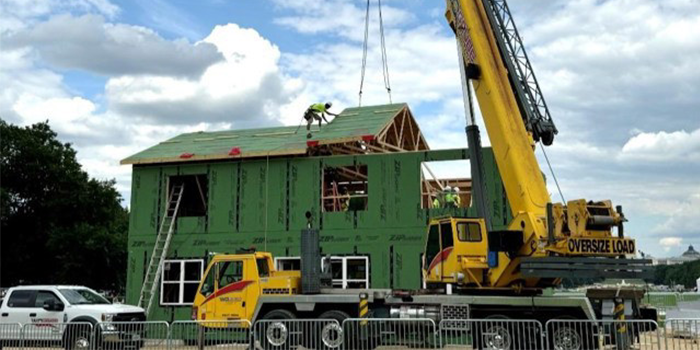Spray Foam Robot Included on National Mall's Showcase of Building Envelope Achievements

WASHINGTON D.C. – July 22, 2024 – Last month, the U.S. Department of Energy's Oak Ridge National Laboratory unveiled its innovative low-carbon building tool on the National Mall in Washington, D.C. The laboratory said the technology could reduce costs and installation times by over 25%.
CleanTechnica reported that ORNL introduced its construction technology during the U.S. Department of Housing and Urban Development's Innovation Housing Showcase in early June. This marked a huge milestone for the real-time building evaluator tool as it demonstrated its capabilities in a real-world construction setting outside a lab for the first time.
The groundbreaking tool aims to deliver on two essential goals in the construction sector: decarbonizing buildings by 2050 with the help of low-cost, energy-efficient technologies and greatly increasing affordable housing options, all while saving time on construction, the outlet explained.
ORNL researchers partnered with the Structural Building Components Association to demonstrate the technology in action as it helped to quickly build a two-story duplex with prefabricated panels before the event started. They plan to donate the home to Habitat for Humanity, per CleanTechnica."This event provides an exciting opportunity to showcase building envelope achievements," ORNL's Diana Hun, who leads the Building Envelope Materials Research group, said in a news release. "We appreciate the opportunity to help SBCA successfully construct their building by using our real-time evaluator to speed the construction pace by providing accurate measurements for precise installation."
The building evaluator tool provides crane operators and builders with exact measurements and positioning instructions for placing prefabricated construction materials. Real-time data is generated by an autonomous robotic tracker and cutting-edge software to help speed up construction and reduce mistakes.
ORNL also displayed several other building innovations it has developed at the housing showcase, including an autonomous spray foam robot that it says cuts the cost of installing insulation foam by 20% and boosts quality and thermal performance by 10%, all without the use of harmful chemicals.
Advanced manufacturing researchers from the DOE also showcased part of a 3D-printed home made completely of eco-friendly materials, called the BioHome3D. It's the nation's first 3D-printed home constructed entirely of biobased components, as ORNL explained.
These technologies will contribute to the DOE's Building Technologies Office's aim of eliminating carbon pollution in buildings by 2050. The innovations will also help increase energy efficiency in homes, reducing homeowners' electric bills and making residences more comfortable.
According to the UN Environment Programme, buildings are the largest contributor to carbon pollution globally, accounting for 37% of pollution. Curbing these heat-trapping gases is crucial to help protect both people and the planet from the dangerous effects of our warming world.
Thankfully, breakthroughs in planet-friendly construction technology are happening worldwide, with a housing developer in France building a complex made of 100% recycled concrete to a company developing weather-proof, Lego-like construction blocks.
For use by SprayFoamMagazine.com & Spray Foam Magazine
Disqus website name not provided.




































